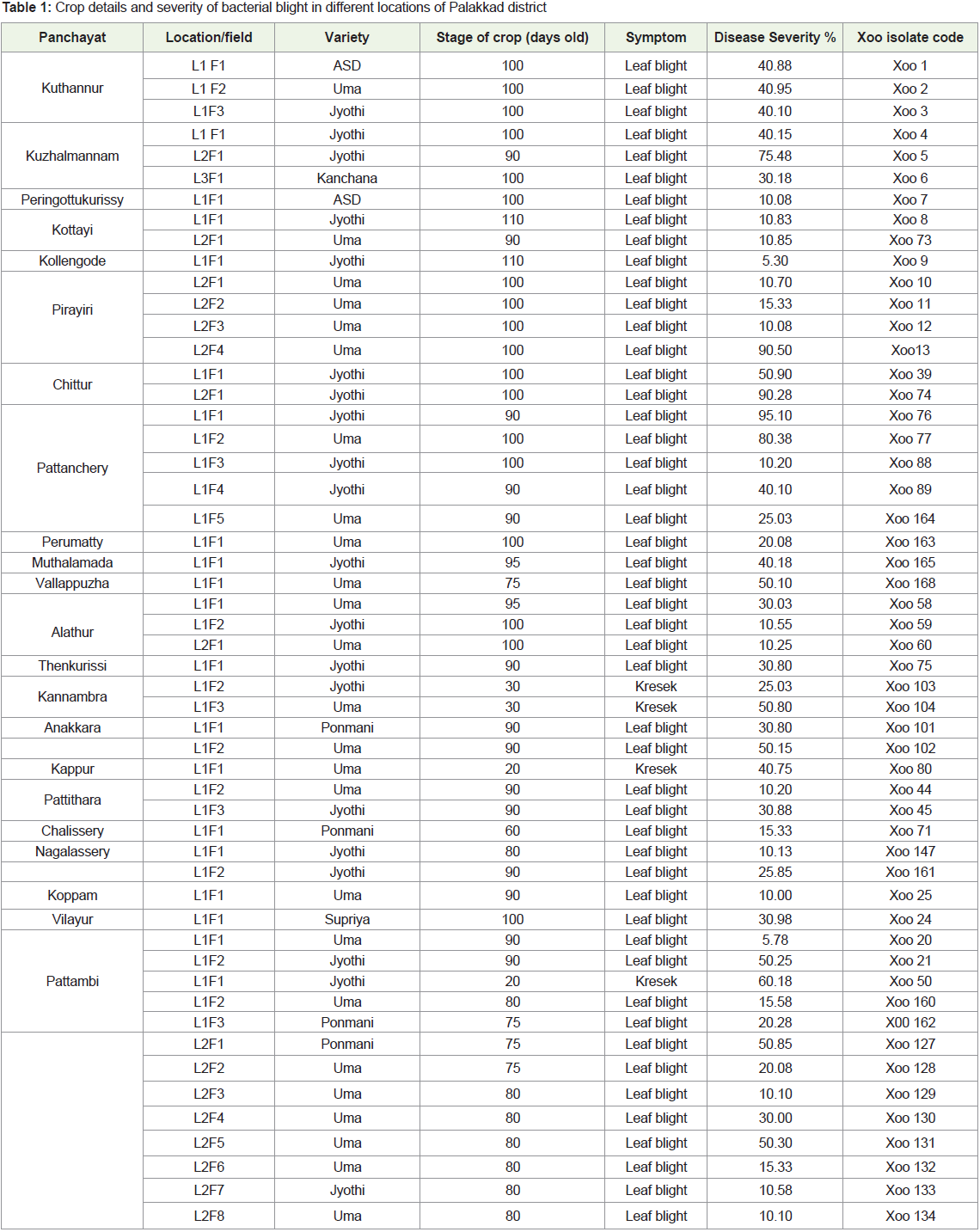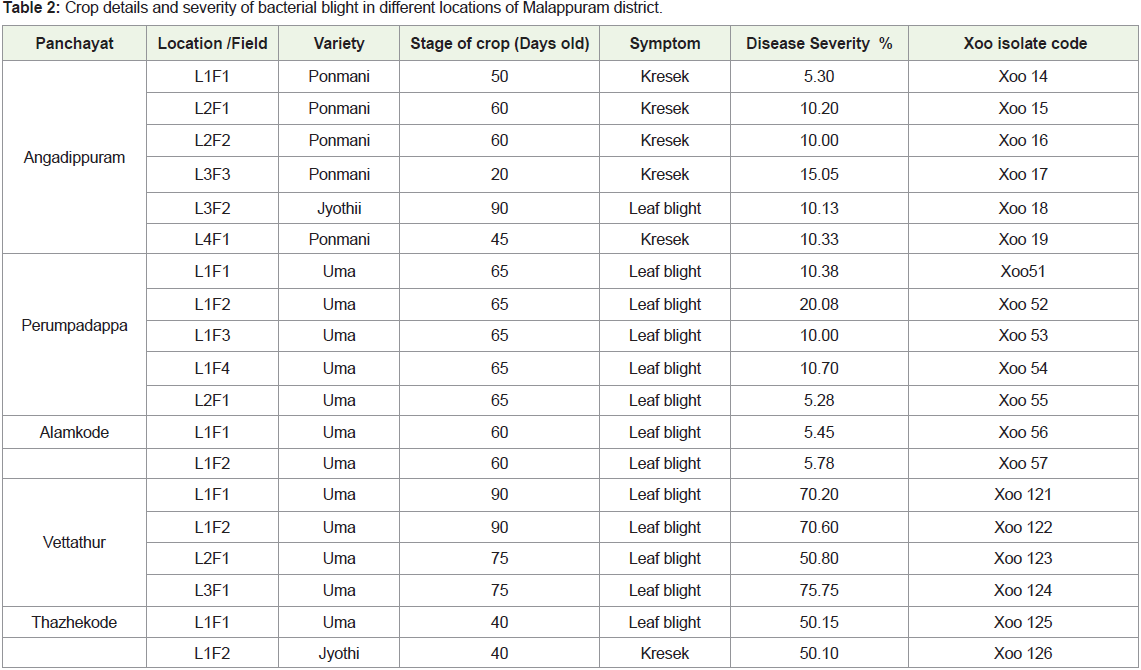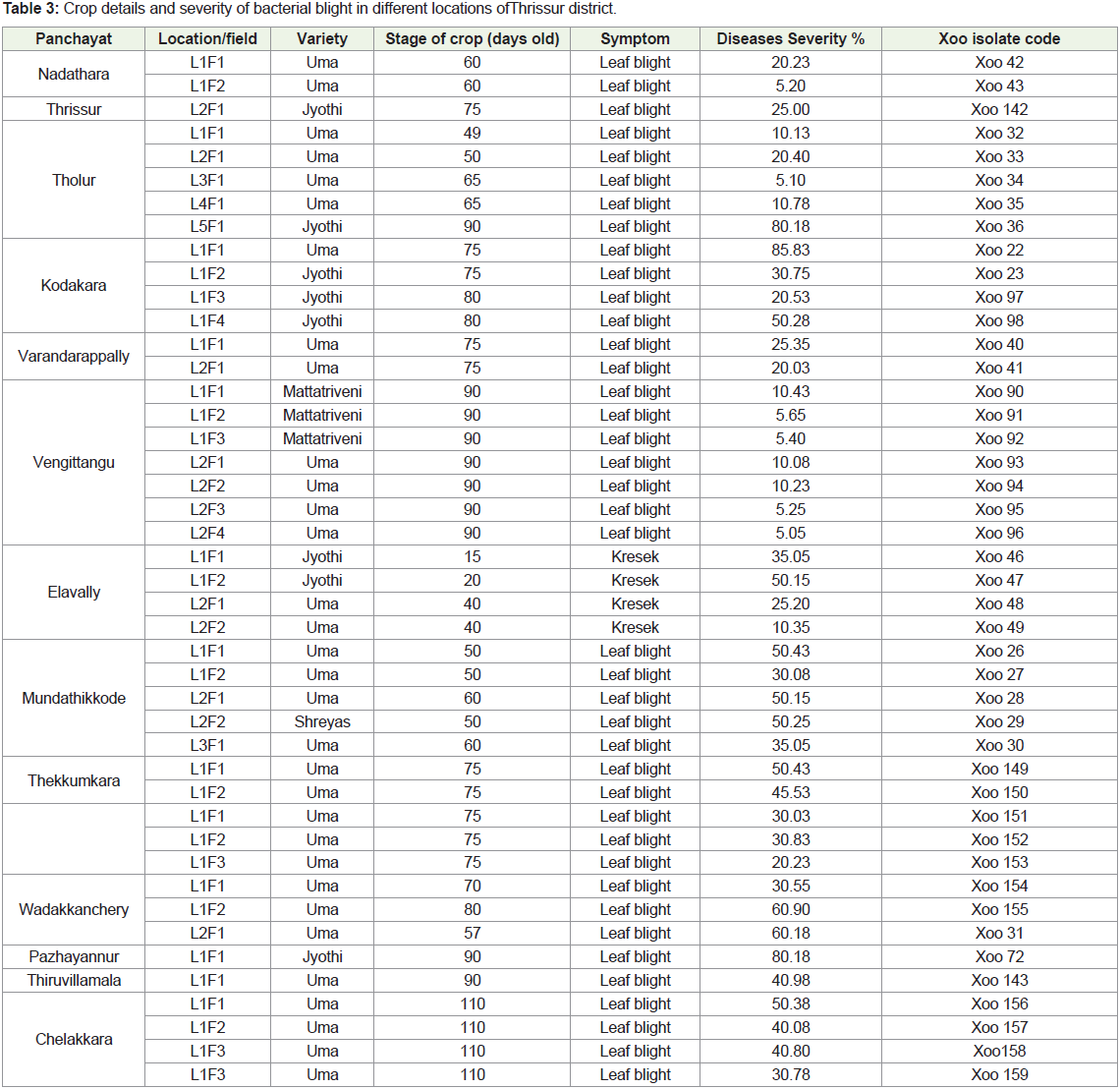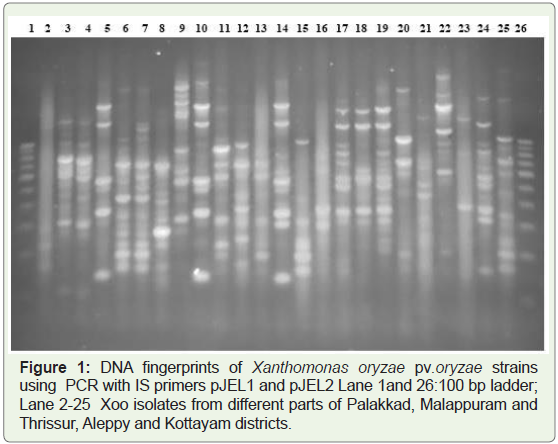Research Article
Occurrence of Bacterial Blight of Rice in Kerala State and Variability Among the Isolates of the Pathogen, Xanthomonas oryzae pv.oryzae
Aparna VS1*, Raji P2 and Sumiya KV3
1College of Agriculture, Vellanikkara, Thrissur, Kerala, India
2Regional Agricultural Research Station, Pattambi, Kerala, India
3Krishi Vigyan Kendra, Palakkad, Kerala, India
*Corresponding author: Aparna VS, College of Agriculture, Vellanikkara, Thrissur, Kerala, India,
Email:aparnavs.13@gmail.com, Phone- +919400462342
Copyright: © Aparna VS, et al. 2023. This is an open access article distributed under the Creative Commons Attribution License,
which permits unrestricted use, distribution, and reproduction in any medium, provided the original work is properly cited.
Article Information: Submission: 10/12/2022; Accepted: 12/01/2023; Published: 16/01/2023
Abstract
Bacterial blight of rice caused by Xanthomonas oryzae pv.oryzae is becoming a major production constraint worldwide. In India, the disease has been
reported to be major threat causing yield loss. In the state of Kerala disease is appearing in an epidemic nature during kharif season in recent years. A survey
has been carried out to assess the intensity of the disease in major rice growing districts of the state and to isolate pathogen from different locations. The
predominantly cultivated rice varieties in farmers field such as Uma and Jyothi were affected in all the districts surveyed viz., Palakkad, Malappuram and
Thrissur. Both kresek as well as leaf blight symptoms were observed. The severity of the leaf blight upto 95.10 per cent was recorded in variety Uma and 90.5
per cent in variety Jyothi. kresek symptom was observed in Palakkad, Malappuram and Thrissur districts in varieties Jyothi, Uma and Ponmani. In Palakkad
district the disease severity ranged from 5.28 to 50.80 per cent. In Malappuram district kresek symptom was observed in Ponmani and the severity ranged
from 10.13 to 15.05 per cent. In Thrissur district kresek symptom was recorded in variety Jyothi and Uma, the disease severity ranged from 10.35 to 50.15
per cent. The 168 Xanthomonas oryzae pv.oryzae isolates from different locations of major rice growing tracts varied in their virulence upon inoculation to
the susceptible variety Jyothi. The disease severity caused by the isolates ranged from score 5 to score 9. The disease reaction caused by the Xoo isolates
varied widely indicating the variability.The genetic variability was further tested by DNA fingerprinting of representative isolates from different districts, which
showed high variability among the isolates. Further studies on pathotyping of the Xoo isolates are needed to understand the genes/ gene combinations
effective for imparting broad spectrum resistance to rice varieties against prevailing pathogen population of the state.
Keywords
Bacterial Blight; Rice; Genetic Variability; Xanthomonas oryzae pv.oryzae
Introduction
Bacterial blight caused by Xanthomonas oryzae pv.oryzae is a
devastating disease of rice causing considerable yield loss worldwide.
The losses due to this disease depends on the crop stage, variety
of the crop and climatic condition. The yield loss ranging from
20 to 80 per cent has been reported by various researchers. [1-3].
Understanding the pathogen population prevailing in a geographical
area is important for the development of management strategies. Periodic survey to assess the disease occurrence andstudy of pathogen
population is essential for understanding evolution new pathotypes
of the pathogen. Many of the resistance genes have been used and
transformed to several cultivars [4,5]. However large scale and longterm
cultivation of the varieties would result in its breakdown of
resistance. Survey and study of the pathogen population have helped
to report resistance status of predominant varieties as well as the
structure of pathogen population [6,7]. In Kerala, bacterial blight
of rice is causing yield loss recently in every year particularly during kharif season. After the floods experienced during the years 2018 and
2019, the incidence of bacterial blight has increased in all the major
rice growing areas of the state. Understanding the extent of severity
of the disease in predominantly cultivated varieties of the state and
the structure of the pathogen population prevailing in the state is
essential for the development of control measures of bacterial blight
of rice in Kerala. The present study was taken up to assess the severity
of bacterial blight in major rice growing districts of the Kerala viz.,
Palakkad, Thrissur, Malappuram, Alappuzha and Kottayam and to
collect pathogen for studying the virulence pattern as well as the
variability.
Materials and Methods
Survey:
A purposive sampling survey was conducted to assess the
occurrence and severity of bacterial blight of ricein major rice
growing districts of Kerala state viz., Alappuzha, Kottayam, Thrissur,
Palakkad and Malappuram during the years 2018 and 2019. During
the survey 52 panchayats coming under these five districts were
covered. In Palakkad 24 panchayats viz., Kuthannur, Kuzhalmannam,
Peringottukurissi, Kottayi, Kollengode, Pirayiri,Chittur, Pattanchery,
Perumatty, Muthalamada, Vallappuzha, Alathur, Thenkurissi,
Kannambra, Anakkara, Kappur, Pattithara, Chalisseri, Nagalasseri,
Koppam, Vilayur, Pattambi, Ongallurand Kumaramputhur. 82
fields were surveyed from 31 locations coming under these 24
Panchayats. In Malappuram district, the survey was conducted in
five panchayatsviz., Angadippuram, Perumpadappa, Alamkode,
Vettattur and Thazhekode. 20 fields were covered during the survey.
In Thrissur district, 13 panchayts viz., Nadathara, Thrissur, Tholur,
Kodakara, Varandarapally, Venkitangu, Elavally, Mundathikode,
Thekkumkara, Wadakkanchery, Pazhayannur, Thiruvilwamala and
Chelakkara, were surveyed.Four panchayats viz., Vaikom. Vechoor,
Thalayazham and Arpookkara were surveyed in Kottayam district.
Five panchayats in Alappuzha district, viz., Thakazhi, Karuvatta,
Chambakkulam, Edathua and Mannar were covered during the
survey. During the symptoms observed, disease severity, stage of the
crop and variety were recorded.Collection of Diseased Plants:
Rice plants showing the typical symptoms of bacterial blight,
kresek as well as leaf blight were collected from the fields surveyed
for the isolation of the pathogen. The samples were collected in
polythene bags and brought to the laboratory for isolation of the
pathogen. For long term storage the freshly collected infected leaf
samples were cut into small pieces and kept in small plastic tubes on
cotton in which calcium chloride wasadded and stored at 40C for long
term preservation.Isolation of Bacterial Blight Pathogen Xanthomonas oryzae pv.oryzae:
Freshly collected samples showing typical bacterial blight
symptoms were used for isolation of the pathogen. Isolation of
Xanthomonas oryzae pv.oryzae was carried out on Peptone Sucrose
Agar medium (PSA). Diseased samples were washed in tap water for
removing the external materials. The leaf samples were cut into small
pieces of size one cm along with some healthy tissue. The leaf bits
surface sterilized using 0.1 per cent mercuric chloride for 30 seconds,
then washed thrice thoroughly with sterilized distilled water. The leaf bits were transferred to a sterilized Petri plate and added 0.5 ml of
sterile water. The leaf bits were crushed using forceps until the water
turns turbid. By using a heat sterilized loop, a loopful of the water
containing the bacterial ooze was streaked on peptone sucrose agar
(PSA) media in plates. The plates were incubated at 280C for 3 - 4 days.
After the development of bacterial colonies, based on morphological
and cultural characters single yellow colonies were picked up and sub
culturedinto peptone sucrose agar slants. Bacterial cultures were also
stored in 15 per cent glycerol at -20oC for long term preservation. A
total of 168 isolates were purified and maintained. The Xanthomonas oryzae pv.oryzae cultures were serially numbered starting from Xoo1
onwards.Pathogenicity Studies:
To prove the pathogenicity of Xanthomonas oryzae pv.oryzae
isolates suspension of 48 hour old culture was clip inoculated on
local variety Jyothi. Seeds were sown in pots and grown in glass
house. 20 days old seedlings were transplanted to pots filled with
potting mixture. Three plants per pot were transplanted. Other
cultural practices as per recommendations were followed. Plants were
inoculated 40 days after transplanting with individual isolates of Xoo
separately adopting clip inoculation [8]. The leaf tips were cut off by
using sterilized scissors dipped in bacterial suspension containing 108
CFU/ml. The observations were recorded 15 days after inoculation as
per Standard Evaluation System scale of IRRI (2013) [9].DNA fingerprinting of representative isolates of bacterial blight pathogen:
1. Xanthomonas oryzae pv.oryzae cultures were grown in 1.5 ml
of LB broth for 15 hours at 28ºC on a rotary shaker (200 rpm).
Genomic DNA was extracted by the procedure of Leach et al (1990)
[10]. PCR amplification of the DNA was performed as described
by George et al (1995) [11] with slight modifications. Reaction was
performed in 25μl volume, containing 50 picomoles each of the
two opposing primers, pJEL1 (5’CTCAGGTCAGGTCGCC3’) and
pJEL2 (5’GCTCTACAATCGTCCGC3’) complementary to each end
of IS1112, 20 ng of genomic DNA, 185μM each of four dNTPs, 2.5
units of Taq polymerase in 1x taq polymerase buffer containing 1.5
% Mgcl2 supplemented with 10% dimethysulfoxide (vol/vol), and
7.5 μl of Tris-HCl (pH-9.5). The reaction mixture was overlaid with
one drop of mineral oil, initially denatured for one minute at 940C,
and then subjected to 35 cycles of PCR (10 s denaturation, at 940C,
one minute annealing at 620C and 8 minuteextension at 650C) and a
final extension for 8 minutes at 650C using Master cycler Eppendorf.
Electrophoresis was carried out using gel containing agarose 0.5%
+ Synergel 0.75% in 0.5X tris borate buffer for 4 hours ata voltage
of 100 V, stained with ethidium bromide and documented in gel
documentation system (Bio-Rad, USA).Results
A purposives ampling survey was conducted to study the
occurrence and intensity of bacterial blight disease of rice in major rice
growing tracts of Kerala and to isolate pathogen form these places.
Survey was conducted in five districts viz, Palakkad, Malappuram,
Thrissur, Kottayam and Alappuzha covering 52 panchayats. The
details of survey locations, the varieties grown in different locations,
stage of the crop, symptoms noticed and disease severity are given in
Tables 1 to 5. In Palakkad district among the 24 locations surveyed, the leaf blight severity ranging from 5.30 to 95.10 per cent was
recorded (Table 1). The kresek symptom was noticed in six locations
and the severity ranged from 5.28 to 60.18 per cent. The highest
severity was recorded in eastern parts of the district Chittur (90.28
%) and Pattancheri (95.10 %) in variety Jyothi. During the period of
survey, in most of the fields the crop was in reproductive phase which
is highly susceptible to the disease. Among the 82 fields surveyed, 24
fields were under cultivation of variety Jyothy and in 35 fields the
variety cultivatedwas Uma. The other varieties grown in the district
affected with disease were ASD (10.08 -40.88 %), Kanchana (30.88%),
Ponmani (15.33 to 50.85%), Mattatriveni (20.95%), Annapoorna
(10.85%). The upland varieties Kattamodan (10.20%), Karuthamodan
(10%), Swarnaprabha (15.25%) and Vaisakh (35.78%) showed
relatively less severity in upland condition. kresek symptom was
observed in varieties Jyothi, Uma and Ponmani in earlytransplanted
stage in six fields surveyed.
In Malappuram district, five Panchayats covering 19 fields were
surveyed (Table 2). In one panchayat, Angadippuram, in five locations
the variety Ponmani and in one location Jyothi was grown. The crop
was in early transplanted stage and was affected by kresek phase of
bacterial blight.In other fields surveyed covering three panchayats,
Uma variety was in flowering stage. The leaf blight symptom ranging
from 5.28 to 75.75 per cent severity was recorded. In one panchayat, Thazhekode, in two fields, the varieties Uma and Jyothi were in early
transplanted condition where kresek symptom was recorded (5.33 -
15.05% severity).
Table 2: Crop details and severity of bacterial blight in different locations of Malappuram district.
In Thrissur district 13 panchayats covering 29 locations in which
44 different fields were surveyed (Table 3). In 32 fields the variety
cultivated was Uma and the disease severity ranged from 5.25 percent
(Nadathara and Venkitangu) to 85.83 per cent (Kodakara). In two
fields kresek symptom was noticed in 10.35-25.25 per cent severity.
In 8 fields surveyed variety Jyothi was cultivated. Disease severity
ranged from 25-80.18 per cent. In two fields where direct sowing was
practiced, kresek symptom was recorded at 35-50.15 percent severity
level in variety Jyothi and 10 to 25 percent in variety Uma. The other
varieties affected with leaf blight wereMattatriveni (5.40-10.43%) in
three fields of other panchayats and Shreyas in one location (50.25%).
In Alappuzha district, survey was carried out in five panchayats,
eightlocations covering11 fields (Table 4). Variety Uma was cultivated
in seven fields and Jyothi was cultivated in three fields. The crop was
in flowering to maturity stage. Bacterial leaf blight was noticed 10.63-
70.68 per cent severity in variety Uma. In Jyothi 5.38- 50.70 per cent
severity was noticed.
Table 4: Crop details and severity of bacterial blight in different locations of Alappuzha district.
In Kottayam district, among the four panchayats surveyed the
variety Uma was grown in all the 11 fields except one where IR5 was
grown (Table 5). The crop was in maturity stage. In all the surveyed
locations leaf blight symptom was recorded. The disease severity
ranged from 5.45 to 50.63 per cent.
Isolation of the Pathogen:
The pathogen was isolated from the all the diseased samples
collected from different locations five districts surveyed, in peptone
sucrose agar medium. Yellow pigmented bacterial colonies typical
to that of Xanthomonas oryzae pv.oryzae were picked up and sub
cultured on to PSA slants and maintained at -200C. 168 isolates were
obtained from different locations.Pathogenicity and Virulence Studies:
Pathogenicity of the all the isolates were proved by inoculation to
susceptible variety Jyothi. The bacterial isolates produced symptoms
on the test variety upon inoculation. The pathogen was reisolated
from the symptomatic plants and upon reisolation the same
bacterial isolate wereobtained. The severity of symptoms obtained
on the susceptible variety Jyothi varied with the isolate, showing the
variability in virulence among the Xanthomonas oryzae pv.oryzae
isolates. The data is given in table 6. The disease severity varied from
14.37 per cent (Score 5) to 60.93% (Score 9). Among the 168 isolates,
14 isolates (8.33% produced highly susceptible reaction with score 9,
128 isolates (76.19 %) produced susceptible reaction with score 7 and
26 isolates (15.48%) produced moderately susceptible reaction with
score 5 upon artificial inoculation on susceptible variety Jyothi.Genetic Variability Studies:
To understand whether there is variability exists among the
isolates of Xoo, DNA fingerprinting analysis using IS112 and IS113
repetitive element-based primers JEL1 and JEL2 was carried out for 24
isolates representing different locations from five districts. The genetic fingerprinting revealed high genetic variability among the isolates
even within a small geographical area (Figure 1). Fingerprinting
showed distinct banding patterns. Fingerprints comprising to 15
bands were generated with JEL1 and JEL2 primers. The number and
position of bands varied for different isolates showing the difference
among the isolates.Discussion
The survey conducted in major rice growing tracts of Kerala
revealed the wide spread occurrence of bacterial blight of rice. The
predominantly cultivated varieties Uma and Jyothi were affected
in moderate to severe intensities. Among the districts surveyed,
the disease severity was high in Palakkad district. In variety Jyothi
the highest severity recorded was 90.5 per cent and in Uma it was
95.10 per cent. This was followed by Thrissur district, where the
highestdisease severity of 85.35 per cent and 80.18 per cent was
recorded in varieties Uma and Jyothi respectively. In Malappuram
district, highest disease severity recorded in variety Uma was 75.75
per cent. Jyothi was cultivated in only one field surveyed where the
disease severity was low (10.13%).In Alappuzha district, the highest
disease severity recoded in variety Uma was 70.68 and in variety
Jyothi was 50.70 per cent. In Kottayam district, in all the locations
surveyed except one, the variety cultivated was Uma and the highest
severity recorded was 50.63 per cent. The incidence of bacterial
blight as major disease of rice has been reported from the states of
Punjab, Haryana, Uttaranchal, Bihar, West Bengal, Tripura, Assam.
Tamil Nadu, Uttar Pradesh, Andhra Pradesh, Andaman and Nicobar
Islands, Maharashtra, Chhattisgarh, Gujarat, Himachal Pradesh,
Karnataka and Kerala [12]. The bacterial blight epidemics causing
yield loss due to bacterial blight ranging from 30 to 90 per cent
have been reported by several researchers depending on the variety
cultivated, stage of the crop and climatic conditions [2,13-15]. The
yield loss 10-20 percent is common. In the state of Kerala, after the
floods experienced during the year 2018 and 2019, the incidence and
spread of bacterial blight has increased considerably. The systematic
collection of diseased samples, isolation of pathogen and study of its
virulence is important to develop effective management strategies including development of resistant varieties. Similar studies were
conducted in the states of India such as Punjab and Andhra Pradesh.
Rajarajeswari and Muralidharan (2008) [16] conducted a study to
assess the occurrence of bacterial blight of rice in four rice growing
districts of Nellore (Andra Pradesh), Rangareddy (Andra Pradesh),
West Godavari (Andra Pradesh), Karnal (Haryana). Singh et al
(2003) [6] reported the prevalence and intensity of bacterial blight in
10 districts of Punjab. Rafi et al (2013) [17] conducted a survey and
reported the disease incidence and severity of bacterial blight in all
rice growing zones of Pakistan.
The inoculation of the isolates in susceptible variety Jyothi revealed
that the isolates from different locations are highly virulent capable
of producing moderately susceptible to highly susceptible disease
response. This indicates the chances of epidemics in predominant
varieties like Jyothi is very high under favourable climatic conditions
due to the prevailing pathogen population in different rice growing
tracts of the state. Among the isolates 168 isolates collected, all the
isolates are virulent on the susceptible variety Jyothi causing a reaction
of moderately susceptible (score 5) and above up to the maximum score
of 9 (highly susceptible). The disease response varies with the isolates
indicating the variability among the isolates. Bakade et al (2020)
[18] studied the virulence of Xoo isolates collected from different
geographical regions of South India by inoculation of one susceptible
variety TN-1. They reported high variability among the isolates in
their virulence.
To confirm the existing variability of the pathogen as evidenced
from the pathogenicity studies, genetic variability of representative
Xoo isolates from various locations were carried out. It revealed high
genetic variability among the isolates.The existence of high genetic
variability of bacterial blight pathogen of rice Xanthomonas oryzae pv.oryzae isolates from different parts of Punjab was reported by
Singh et al 2003 [6] and Lore et al 2011 [7]. All these suggests the
need for a detailed study on pathogen population prevailing in the
state particularly pathotyping of the pathogens on differentials / NILs
carrying different resistance genes so as to identify the resistance
genes/gene combinations effective against the prevailing pathotypes
of the state.
Conclusion
A survey has been carried out in five major rice growing districts
of Kerala to assess the severity of disease in predominant varieties
of the state and collect the pathogen isolates. The predominant
rice varieties Jyothi and Uma grown in these districts were affected
severely by bacterial blight even up to 90-95 per cent. This suggests
an urgent need to replace these mega varieties of the state with
new varieties with bacterial blight resistance. Among the districts
surveyed bacterial blight was more widely seen with high intensity in
Palakkad district, the rice bowl of Kerala. 168 isolates collected from
different locations of the state varied in their virulence on susceptible
variety Jyothi. The DNA fingerprinting of representative isolates
from different locations exhibited high variability. Further studies on
pathotypic variability and identification of genes/gene combination effective against major pathotypes prevailing in the state is essential
for development of bacterial blight resistant varieties suitable for the
state of Kerala.






